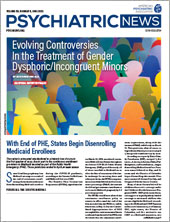Some 15 million people may lose Medicaid coverage as a result of the end of continuous enrollment policies that barred states from disenrolling Medicaid enrollees during the COVID-19 pandemic, according to the Centers for Medicare and Medicaid Services (CMS).
The Families First Coronavirus Response Act (FFCRA), signed into law on March 18, 2020, mandated continuous Medicaid enrollment throughout the federal COVID-19 Public Health Emergency (PHE) period for nearly all of those enrolled in Medicaid on or after the date of enactment of the law. In exchange for meeting these and other provisions, the FFCRA temporarily increased the federal medical assistance percentage (FMAP, the amount the federal government contributes to each state’s Medicaid program) by 6.2 percentage points.
The FFCRA would have allowed the continuous enrollment policy to remain in effect until the end of the first month when the PHE was ended, which was on May 11. But the Consolidated Appropriations Act of 2023 uncoupled the continuous enrollment condition from the end of the PHE, with the result that the continuous enrollment requirement, along with the increased FMAP, ended early on March 31. This provision allowed states to begin disenrollment processes on April 1, but specific timelines vary by state.
According to a report by Kaiser Family Foundation (KFF), on April 1, five states—Arizona, Arkansas, Idaho, New Hampshire, and South Dakota—began disenrolling Medicaid enrollees. Fourteen states followed in May, and 21 states and the District of Columbia began disenrolling this month. Nine more states will disenroll in July, and Oregon will be the last in October.
Many of those disenrolled will be children who receive coverage under the Children’s Health Insurance Program (CHIP). CHIP gives states financial support to expand publicly funded coverage to uninsured children who are not eligible for Medicaid. According to the
Medicaid and CHIP Payment and Access Commission, as of January 2017, eight states, the District of Columbia, and five territories ran CHIP as a Medicaid expansion, two states operated separate CHIP programs, and 40 states operated a combination program.
According to a 2022
report by KFF, as of 2020 an estimated 39% of Medicaid enrollees had a mental illness and/or substance use disorder, relative to 31% of privately covered and uninsured people. An estimated 11% of adults with Medicaid had both a mental illness and a substance use disorder, relative to 7% of privately covered people and 8% of uninsured people.
An
Issue Brief released in August 2022 by the Health and Human Services (HHS) Office of Health Policy estimated the likely effect of the end of the PHE on Medicaid enrollment. Using longitudinal survey data and 2021 enrollment information, the office projected the following:
•
Approximately 15 million people (17.4%) enrolled in Medicaid or CHIP will leave the program based on historical patterns of coverage loss.
•
Approximately 6.8 million people (7.9%) will lose Medicaid coverage despite still being eligible because of what is known as “administrative churning.” The latter refers to bureaucratic hurdles that lead to lost coverage because of missed notices, incorrect paperwork, or other reasons. In addition, 9.5% of Medicaid enrollees (8.2 million) will leave Medicaid due to loss of eligibility and will need to transition to another source of coverage. (Medicaid eligibility is determined by income and other demographic factors.)
•
Children and young adults will be impacted disproportionately, with 5.3 million children and 4.7 million adults aged 18 to 34 predicted to lose Medicaid/CHIP coverage. Nearly 33% of these individuals are Latino (4.6 million) and 15% (2.2 million) are Black.
•
An estimated 383,000 individuals projected to lose eligibility for Medicaid fall in the coverage gap in the 12 states that have not expanded income eligibility for Medicaid under the Affordable Care Act.
HHS noted in its Issue Brief that approximately one-third (5 million) of disenrolled individuals are likely to obtain other coverage (typically through an employer), and nearly 3 million might have a subsidized option under the Healthcare Insurance Marketplaces established by the Affordable Care Act. “Additionally, some individuals who lose Medicaid eligibility at the end of the PHE may regain it, and some individuals who lose coverage despite being eligible (because of churning) may re-enroll.”
Regardless, the end of the PHE likely marks a tumultuous period for millions of Medicaid enrollees. The Issue Brief notes that the uninsured rate declined to a historic low of 8.0% in the first quarter of 2022, due in part to the continuous enrollment provision in Medicaid as well as strong enrollment outreach efforts and expanded subsidies under the COVID-19 Stimulus Package, also known as the American Rescue Plan.
Between February 2020 and December 2021, Medicaid enrollment grew by approximately 15.5 million individuals, from 71.2 million to 86.7 million. “Research indicates that Medicaid enrollment growth during the pandemic was primarily driven by increased retention of existing enrollees rather than new applications,” according to the Issue Brief.
“Youth mental health care was already in crisis before COVID,” said Sandra DeJong, M.D., senior consultant to the Child and Adolescent Psychiatry Training Program at Cambridge Health Alliance and former APA secretary. “The pandemic has acutely exacerbated the situation. Major pediatric and child mental health organizations, including the American Academy of Child and Adolescent Psychiatry, American Academy of Pediatrics, and the Children’s Hospital Association have declared a state of emergency.
“That is the backdrop to this new crisis of disenrollment, which will disproportionately worsen access to care for our most vulnerable patients,” she told Psychiatric News. “Public sector and community-based child psychiatrists and their teams will have an additional burden of trying to protect those who are incorrectly unenrolled or who need to transfer to a new insurance. These are huge logistical hurdles. I hope HHS will collaborate with psychiatrists on the ground to lessen this burden.” ■

